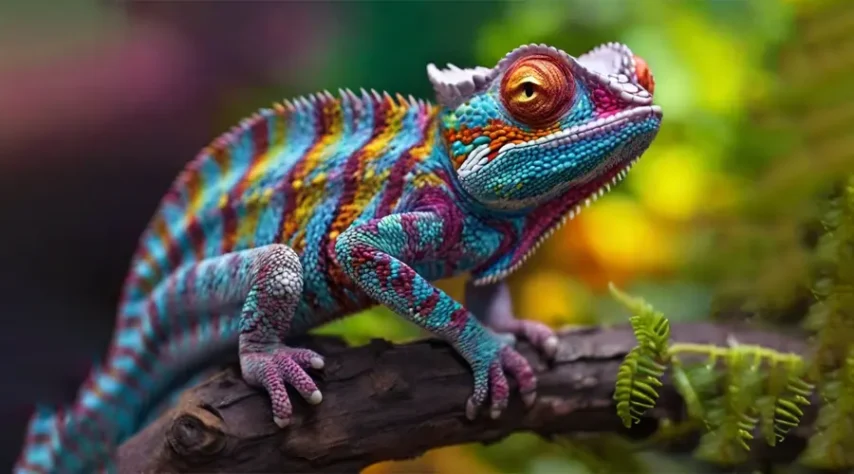The marvel that is the chameleon’s chromatic mastery unfolds as an intricate tapestry woven with perplexing threads, captivating the imagination with a burst of colors that defy the ordinary. This enigmatic reptile, renowned for its ability to metamorphose its skin into a living canvas, beckons us to delve into the mysteries of its color change, a phenomenon that transcends the mundane and embraces the extraordinary.
To decipher the chameleon’s chromatic prowess, we embark on a journey into the very fabric of its existence – the skin. Unlike the commonplace reliance on chromatophores seen in other species, the chameleon boasts an avant-garde combination of specialized cells and minuscule wonders known as nanocrystals. These nanocrystals, nestled within the chameleon’s skin, contribute to the elusive and mesmerizing nature of its color change.
Enter the realm of chromatophores, the color-altering cells scattered across the animal kingdom. Within these cells reside pigments that play a vital role in the transformation of the chameleon’s appearance. These pigments, absorbing and reflecting light in a ballet of hues, create the spectacular spectrum of colors that paint the chameleon’s skin. Yet, the chameleon elevates this dance to a symphony with the addition of guanine crystals, the shimmering secret embedded within its skin cells.

Guanine crystals, minuscule structures on a microscopic scale, function as clandestine mirrors within the chameleon’s skin cells. When the chameleon is at ease, these crystals huddle together, reflecting shorter wavelengths of light and conjuring a serene blue hue. The chameleon’s skin becomes a canvas of reflective poetry, responding not only to external stimuli but also to the internal rhythm of its emotions.
Contrary to the common narrative that confines chameleon color change to a mere camouflage tactic, the chameleon, with its dynamic palette, communicates a spectrum of emotions. It transforms not only to elude predators but also to express excitement, aggression, or courtship. The kaleidoscopic hues are a living mood palette, a language of emotions painted across the chameleon’s skin in strokes of vibrant reds, blues, and greens.

As the chameleon navigates its environment, its color-changing abilities extend beyond emotional expression to encompass the art of survival. Camouflage, a strategic dance with its surroundings, allows the chameleon to seamlessly blend into the lush tapestry of a tropical rainforest or become an elusive figure in the arid expanse of a desert. The ability to adapt its coloration becomes a survival strategy, a dance with death where the chameleon plays the roles of both predator and prey.
The intricacies of the chameleon’s chromatic ballet unfold in a choreography involving the nervous system, hormones, and the specialized cells within its skin. Signals from the brain cascade through the chameleon’s body, directing chromatophores to expand or contract, revealing or concealing pigments with each step of the dance. Simultaneously, the guanine crystals pirouette, reorienting themselves to modify the reflective properties of the skin and enhance the overall color transformation. It’s a performance that unfolds at breathtaking speed, a testament to the chameleon’s evolutionary prowess in the grand theater of survival.
To unravel the evolutionary tapestry of chameleon color change is to peer into the complex dance of adaptation. While camouflage often steals the spotlight, the multifaceted nature of color change hints at a broader narrative. In the ceaseless arms race between predators and prey, the chameleon’s ability to become an inconspicuous phantom in its environment offers a strategic advantage. It dances between the shadows, avoiding the gaze of predators and surprising unsuspecting prey with its prowess.
Yet, the chameleon’s color change is not confined to the silent language of survival alone. It is an art of expression, a communicative symphony that resonates in the social fabric of its existence. The vibrant displays, the dynamic hues – these are not just for survival but also for asserting dominance, attracting mates, and securing a place in the intricate web of chameleon society.

As we stand at the cusp of the future, the chameleon’s color-changing wonders transcend the boundaries of biology. Researchers, inspired by this living masterpiece, explore applications that stretch into the realms of technology. Mimicking the principles of chromatophores and guanine crystals, scientists delve into the creation of responsive displays, advanced camouflage materials, and even innovations in medical imaging. The chameleon, with its ever-shifting hues, becomes a muse for the intersection of science and imagination.
In conclusion, the chameleon stands not merely as a creature that changes color but as a living masterpiece that paints its emotions, adapts to its environment, and survives through the ages. As we unveil the mysteries of chameleon color change, we traverse a landscape of wonder, where science meets art, and the boundaries between the ordinary and the extraordinary blur into a burst of perplexity. The chameleon, with its kaleidoscopic palette, invites us to embrace the enigma, inspiring us to ponder the limitless possibilities that unfold at the nexus of science and imagination.







